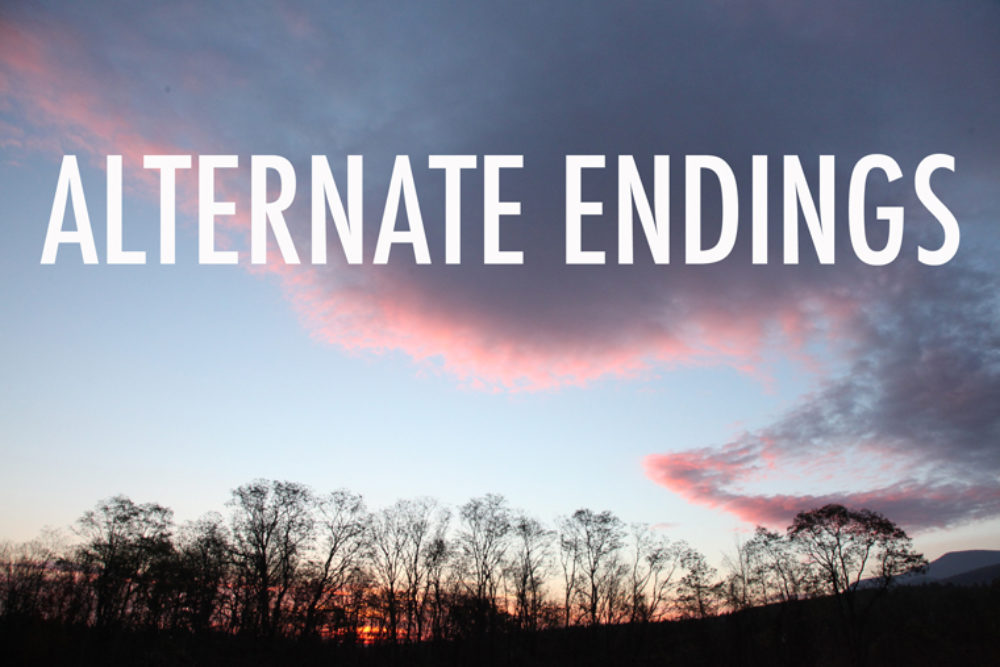
ALTERNATE ENDINGS is a video program for the 25th anniversary of Day With(out) Art featuring provocative work about the ongoing HIV/AIDS pandemic, focusing on the issues of today.
On December 1, 1989, Visual AIDS organized the first Day With(out) Art—a national day of action and mourning in response to the AIDS crisis. To honor the 25th year of Day With(out) Art, Visual AIDS is commissioning seven artists/collaboratives—Rhys Ernst, Glen Fogel, Lyle Ashton Harris, Derek Jackson, Tom Kalin, My Barbarian, and Julie Tolentino/Abigail Severance—to create new short videos to be screened internationally on/around December 1, 2014.
ALTERNATE ENDINGS highlights the diverse voices of seven artists that use video to bring together charged moments and memories from their personal perspective amidst the public history of HIV/AIDS.
The short videos in ALTERNATE ENDINGS use a mix of found footage, live performance, still photos, and robotic cameras to weave together connections between personal stories and public memories. They share tales of love and breakups, sing songs of defiance, celebrate action, and remember those whom we have lost. Through these diverse stories we are invited to reflect upon our complex past as we envision divergent narratives and possibilities for the future, because AIDS IS NOT OVER.
ALTERNATE ENDINGS premired on December 1, 2014 at SVA Theatre in New York City
The video program screened in 56 locations around the world on/around December 1, 2014 for Day With(out) Art / World AIDS Day. See a complete list of screening locations here.
Visual AIDS organized marquee screenings at the SVA Theatre in New York, the Studio Museum in Harlem, the New Museum, and the Queens Museum.
Sugar Hill Children's Museum of Art and Storytelling (in partnership with The Studio Museum in Harlem), The Broad in Los Angeles, and the Museum of Contemporary Art Chicago.
Tom Kalin, Ashes, 2014
For Ashes, Tom Kalin photographed thousands of high resolution still images and "stitched" them into a moving image. While borrowing library books for research on another project, Kalin discovered, glued to the endpapers, ordinary "due date" ledgers stamped with dates spanning three decades. Inspired by these tiny ledgers—like skin or palimpsests that recorded an analogue history, an accumulation of many gestures—Kalin combines quotidian pictures snatched from his daily life with an evocative musical track by ongoing collaborator Doveman (Thomas Bartlett). The film layers dates and moments from Kalin's personal world with the public and global history of AIDS.
Commissioned in 2014 as part of ALTERNATE ENDINGS, a program of seven videos that bring together charged moments and memories from their personal perspective amidst the public history of HIV/AIDS.
About the artist
Tom Kalin is known as a prominent figure in the New Queer Cinema. His critically acclaimed work traverses diverse forms, including experimental films, video installations and narrative feature films. In these works and as a member of the activist collective Gran Fury, Kalin has done significant work to change public opinion of AIDS. Named one of the top 100 American Independent films by the BFI, his first feature, Swoon, was awarded Berlin's Caligari Prize, Stockholm's Fipresci Prize, Sundance's Best Cinematography and the Gotham Awards''Open Palm'. His feature Savage Grace premiered in Cannes, played opening night in Zurich and screened at festivals including Sundance, Karlovy Vary, London and Tribeca. It was nominated for a Spirit Award and named one of the top ten films of 2008 by Artforum and Paper. As a producer his features include I Shot Andy Warhol and Go Fish. He was a writer of Cindy Sherman's Office Killer. He has also created shorts and installations including They are lost to vision altogether, Geoffrey Beene 30, Plain Pleasures, Third Known Nest, Every Wandering Cloud, Behold Goliath, Incontinent and My Silent One. Kalin was a 2011 Guggenheim Fellow. He has twice been included in the Whitney Biennial.
Rhys Ernst, Dear Lou Sullivan, 2014
This work by LA-based artist Rhys Ernst invokes the story of Lou Sullivan, trans man and AIDS activist largely responsible for establishing the distinction between gender identity and sexual orientation. Cut with images of Ernst’s own examination of this figure and trans history, the video is structured by the search for and desire to identify transmasculine elders and an intergenerational exploration of gay transmasculine identity. Utilizing interview footage, excerpts of Sullivan’s book “Information for the Female-to-Male Crossdresser and Transsexual," VHS gay porn, and Grindr chats, Dear Lou Sullivan is a meditation on the life of the late trans man and AIDS activist that explores the bodily intersection of transmasculine gay and HIV+ identity.
Commissioned in 2014 as part of ALTERNATE ENDINGS, a program of seven videos that bring together charged moments and memories from their personal perspective amidst the public history of HIV/AIDS.
About the artist
Rhys Ernst is a filmmaker and artist. His debut feature film, Adam, premiered at the Sundance 2019 Film Festival, won awards at Outfest, Oslo Fusion, and the Mezipatra Film Festival, and was nominated for a 2020 GLAAD award.
He was a Producer and Director on Amazon’s Transparent and created the title sequence for the series. He was nominated for a 2015 Emmy Award for directing and producing the webseries Transparent: This Is Me. In 2016 he teamed up with Focus Features to create the online series, We’ve Been Around.
Ernst has shown work at the Whitney Biennial, the Sundance Film Festival, Oberhausen, the Ann Arbor Film Festival, The Walker and The Hammer Museums; he has won two Special Recognition GLAAD Awards as well as awards at Outfest, Chicago International Film Festival, the L.A. and the Seattle Transgender Film Festivals. He has been awarded fellowships from the Point Foundation, Film Independent’s Project Involve, Sundance FilmTwo, and the Universal Director’s Initiative. He was awarded the 2015 Point Foundation Horizon Award and the ACLU Liberty Award for his work on transgender representation in the media.
He received a BA from Hampshire College and an MFA from CalArts, and lives in Los Angeles.
My Barbarian, Counterpublicity, 2014
My Barbarian's Counterpublicity is a staged video performance based on an essay about Pedro Zamora, AIDS activist and star of the Real World: San Francisco, written by José Esteban Muñoz in his book, “Disidentifications.” The three members of My Barbarian re-perform scenes from The Real World in an alienated style, resisting the affect of "reality tv" even as they interrogate its politics, contrasting these scenes with the embodied performance of 90s-inspired music videos, with lyrics adapted from Muñoz's theory of Queer counterpublic spheres that operate against the dominance of racism and homophobia.
Commissioned in 2014 as part of ALTERNATE ENDINGS, a program of seven videos that bring together charged moments and memories from their personal perspective amidst the public history of HIV/AIDS.
About the artists
For two decades, the members of My Barbarian— Malik Gaines, Jade Gordon, and Alexandro Segade—have used performance to theatricalize social issues, adapting narratives from modern plays, historical texts, and mass media into structures for their performances, videos, music, writing, installations, and exhibitions. Founded in 2000, My Barbarian was the subject of a 2021-2 survey exhibition and performance program at the Whitney Museum of American Art, which included a monograph published by the Whitney Museum and Yale University Press. The group’s work has been presented at LACMA, The Hammer Museum, REDCAT, SFMOMA, MoMA, The Studio Museum in Harlem, The Kitchen, The New Museum, Participant Inc. and many other U.S. venues; and internationally at Museo El Eco, Mexico City; DeAppel, Amsterdam; Townhouse Gallery, Cairo; The Power Plant, Toronto; El Matadero, Madrid, and others. They were included in two Performa Biennials, the Whitney Biennial, two California Biennials, the Montreal Biennial, and the Baltic Triennial. My Barbarian has been supported by USA Artists, the Foundation for Contemporary Arts, the Mike Kelly Foundation, Art Matters, the City of LA Cultural Affairs, and others. According to Catherine Quan Damman, in Artforum, My Barbarian bring “high-theory arcana into bawdy populist forms, marshaling their multicultural demographics to burlesque liberal fantasies of the melting pot, and vamping the world historical only to burn it down and throw a party around the flames.” My Barbarian is represented by Vielmetter Los Angeles.
Julie Tolentino/Abigail Severance, evidence, 2014
In evidence, Julie Tolentino’s naked, moving body articulates backward on her hands and knees, balancing a cluster of Asian medicine cups. The piece, originally made in 2010 in collaboration with Abigail Severance, was remixed for Visual AIDS in 2014. Tolentino's self-made sound piece was added and initiates the video with a queer list of loved ones living and lost, recognizable or not, as both invocation and provocation of individuals who deeply shifted her perspective. As the listed names blur and are archived in Tolentino's body, evidence opens up to the list's potency through a female, brown, artist/activist body in the unseen yet held spaces of relationship, memory, sex and loss.
Commissioned in 2014 as part of ALTERNATE ENDINGS, a program of seven videos that bring together charged moments and memories from their personal perspective amidst the public history of HIV/AIDS.
About the artist
Julie Tolentino’s career spans over two decades of dance, installation, and site-specific durational performance. Her diverse roles have included host, producer, mentor, and collaborator with artists such as Meg Stuart, Ron Athey, Madonna, Catherine Opie, David Rousseve, Juliana Snapper, Diamanda Galàs, Stosh Fila, Robert Crouch, Elana Mann, Mark So, Gran Fury, and Rodarte. Tolentino is deeply influenced by her extensive experience as a caregiver, an Eastern and aquatic bodyworker, a highly disciplined contemporary dancer, and as proprietress of Clit Club in New York. Her manifold, exploratory duet/solo practice includes installation, dance-for-camera, and durational performance engaging improvisation one-to-one score-making and fluids, including blood, tears, and honey. As an extension of her practice after twenty-five years in New York City, she designed and built a solar-powered live–work residency in the Mohave Desert called FERAL House and Studio, where she explores the remote forms of physical inquiry through landscape and texts. She has received numerous grants and fellowships. She is currently the editor of Provocations in the Drama Review-TDR (MIT Press). Her works have been commissioned by The Kitchen, Participant Inc., Invisible Exports, Performa ’05 and '13, and in the UK by Spill Festival, Tramway, DanceExchange, and queerupnorth. Recent tours include England, Europe, Myanmar, the Philippines (at Manila Contemporary and Green Papaya Gallery), and Theaterworks in Singaporeas well as Broad Art Space at University California Los Angeles (UCLA), Los Angeles Contemporary Exhibitions (LACE), Commonwealth & Council, Honor Fraser, PSI19 at Stanford, Perform Chinatown, Install Weho, Cypress College, USC Ecotone, the New Museum, Radical Archives/NYU and YBCA In-Community project. (Special thanks to Abigail Severance & Juvenal Cisneros)

